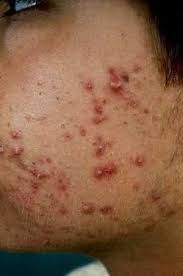Acne normally starts in teenage but it affects adults too. Most of the teenagers get Acne in some form. There are many myths about what causes Acne. here are some of the facts and how to deal with acne. Please do not try to pick or squeeze which may cause inflammation.
Acne consists of spots or painful bumps on the skin. Normally acne is noticeable on the face but it can also appear on the back, shoulders too.
 Acne is due to the way the skin reacts to hormonal changes. There are sebaceous glands on the skin which naturally release sebum, an oily substance which helps to protect it. During the teenage, raised levels of the hormones can cause too much sebum to be produced which can happens in both boys and girls. The sebum can block hair follicles. When dead skin cells mix with the blockage, this can lead to formation of spots or acne. The bacteria in the skin gets multiplied which causes pain and swelling beneath the blockage.
Acne is due to the way the skin reacts to hormonal changes. There are sebaceous glands on the skin which naturally release sebum, an oily substance which helps to protect it. During the teenage, raised levels of the hormones can cause too much sebum to be produced which can happens in both boys and girls. The sebum can block hair follicles. When dead skin cells mix with the blockage, this can lead to formation of spots or acne. The bacteria in the skin gets multiplied which causes pain and swelling beneath the blockage.
You can see different kinds of acne or spots. There is no evidence of acne is caused by what you eat.
Acne consists of spots or painful bumps on the skin. Normally acne is noticeable on the face but it can also appear on the back, shoulders too.
You can see different kinds of acne or spots. There is no evidence of acne is caused by what you eat.
- The black heads are small, blocked pores
- White heads are small, hard bumps with a white center
- Pustules are spots with lot of pus visible
- Nodules are hard, painful bumps under the skin
Treatments for acne
Acne will usually go away on its own, but it can take many years. There are treatments that can help clear acne more quickly. Over-the-counter treatments can help with mild acne. Ask a pharmacist for advice on which treatment could help and how long you will have to use it. You may not see results for several weeks.If over-the-counter treatments don't help, treatments are available on prescription. Your doctor can assess how bad your acne is and discuss the options with you. Don't be afraid to tell your doctor how your acne affects your life and how it makes you feel.
Mild, non-inflammatory acne consists of whiteheads and blackheads. Treatments include gels or lotions that can contain retinoids (vitamin A), topical (applied to the skin) antibiotics, benzoyl peroxide (which is antibacterial) or azelaic acid, which has antibacterial, antinflammatory and exfoliating properties.
These medications, or a combination of them, can also be used to treat mild-to-moderate inflammatory acne, which has some pustules and nodules. It can take up to eight weeks before you see a difference in your skin, and treatment may need to be continued for six months.
In women, contraceptive pills that contain oestrogen can help clear acne.
If acne is severe, your doctor can refer you to a dermatologist who may prescribe a stronger medication called 'isotretinoin' (Roaccutane).Some light and laser therapies also claim to help get rid of acne.
